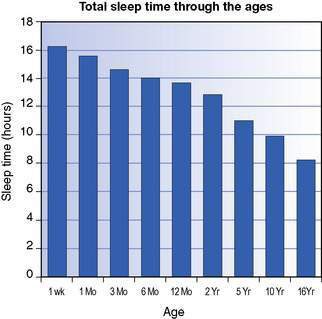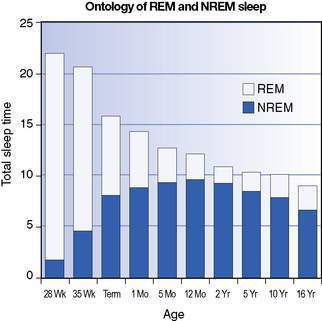3.13 Sleep problems
The physiology and function of sleep
Sleep is defined as ‘a natural and periodic state of rest during which consciousness of the world is suspended’. This is brought about by complex interactions between the reticular activating system and the diffuse set of neuronal centres that facilitate different aspects of sleep. The most important factor appears to be the desynchronization with the cortical centres that are related to consciousness. Sleep has been further differentiated with the help of electroencephalography (EEG) and the current convention for staging of sleep is EEG based. In infancy it is differentiated as active and quiet sleep, and as the development progresses characteristic features are noted and the sleep is broadly divided as rapid eye movement (REM) and non-rapid eye movement (NREM) sleep. The usual pattern is to cycle through these stages throughout the night and to arouse (often at stage changes) a number of times during the night. This structure is often referred to as sleep architecture. The total amount of sleep from birth to adolescence is shown in Figures 3.13.1 and 3.13.2.
• Sleep is noted to restore and recuperate the human body to optimal daytime functioning (restoration theory). NREM sleep is thought to function in reparation of body tissue and REM sleep in restoration of brain tissue.
• Sleep is considered important in the process of learning and memory (learning theory). The unlearning theory complements this process by handling the clutter of information and removing non-essential information in an orderly fashion, thereby facilitating enhanced learning.
• Sleep is considered a facet of evolutionary development, and complexity of sleep is attributed to the complex nature of the human physiological system.
Behavioural aspects of children’s sleep
Unlike adults, infants and young children do not often present with problems in their sleep. The parents present their problem. It is important to evaluate the symptoms properly and assess whether there is a sleep disorder present or just a variation of the normal. The treatment, if any, should be for the child primarily and not necessarily to fulfil parental desire. Age-specific common non-respiratory sleep problems are shown in Table 3.13.1.
• a stable routine that helps with entrainment (external factors that help keep circadian scheduling in a regular pattern)
• settling procedures/relief of anxiety
• entrainment of circadian schedule with regular and stable wake-up and bedtimes
• comfortable non-stimulatory environment
• removal of technology from the bedroom (e.g. televisions, mobile phones, game equipment).







